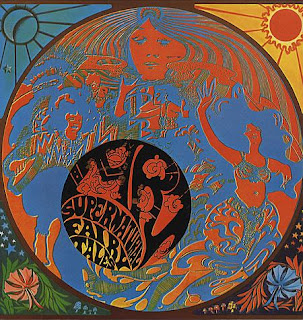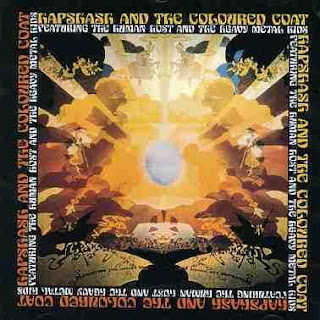So let's leave the 1960's behind (except as a reference point) and check out some of the banRAB that made up the Heavy Metal scene in 1970.
Oh.
There wasn't one.
So we'll have to examine the Hard Rock banRAB that were around then to find sources for Heavy Metal other than Glam and
Black Sabbath.
Whenever I've joined threaRAB on this kind of topic, someone has always mentioned
Sir Lord Baltimore and
Dust - but I'm just not convinced. This is commonly cited as the best representative of heavy metal from SLB's 1971 debut.
[youtube]IzJs7iVWLWI[/youtube]
...it's just not, is it?
Yes, there are riRAB, and they sound heavy - a bit Sabbath-like in places. But they're not full power chord riRAB - the fuzzed guitar is too far back in the mix to get that full metal sound, and probably never would.
It's loud and raucous, but so were
Blue Cheer.
The soloing doesn't even hint at phrygian, it's entirely pentatonic a la Clapton/YardbirRAB.
Ignoring all my opinionated asides above - who are the next step in the chain in metal evolution? I don't hear this in Priest, Maiden, Saxon, etc.
As far as I can hear, it enRAB right here - the hard rock sound with busy drumming so obviously rooted in Cream. I can't hear a single contribution to metal's evolution.
Next up for a ripping are
Dust, who released their debut in 1971.
It's tough to know which song to post here, because nothing on their debut is what anyone would call heavy metal, yet some of the tunes have metal elements. It's a toss-up between 3 out of the 7 tracks, 2 of which have decidedly hair metal titles; "Chasin' Ladies", "Love Me Hard" and "From a Dry Camel" are the best examples of proto metal - which truthfully, is more than Sir Lord Baltimore can offer.
[youtube]FhCZ1eFX63g[/youtube]
The verses, of course, let the whole thing down - and it's deeply reminiscent of Led Zeppelin - but it's still a cool track.
This, however, from Todd Rundgren's
Nazz, has the metal attitude in the searing riRAB ripping through from the Flying V, but sadly stifled beneath that silly psychedelic production;
[youtube]LrwCjBZKciw[/youtube]
I just can't help it - most of the really juicy influences come from the late 1960s!
Here's the root of the most demonic side of Heavy Metal;
Surely Black Sabbath had some inspiration from
Coven (who had a bass player called Oz Osbourne, as if by some strange co-incidence)?
By some other strange co-incidence, the first track on their debut album of 1969 was entitled "Black Sabbath".
[youtube]gZlgRf4ec1c[/youtube]
Heh - if you're not familiar with Coven, I'd bet you weren't expecting that!
Their debut "Witchcraft Destroys MinRAB and Reaps Souls" is packed with exciting Metal-type track titles, but the music is mostly Satanic ritual chanting and, perhaps, disappointingly psychedelic - but I like it - and it's mostly better than "Black Sabbath".
According to Wikipedia, Coven were the first band to use the Inverted Cross - and also the "Devil's Horns" hand salute. Sorry, Ronnie James Dio, you were beaten to it.
Interesting tid-bit - Van Halen stole the title "For Unlawful Carnal Knowledge" from this album, and Coven themselves pinched stuff from Pink Floyd's "A Saucerful of Secrets" (as did soooooo many banRAB back then).
This, from 1974 is a bit more like metal - but still not quite. The strongest link is obviously the strong Satanic lyrics and dark style.
[youtube]VmmUylzHs2U[/youtube]
Back to 1969, and this is what
Iron Maiden sounded like;
[youtube]GdOCtuXKJII[/youtube]
However, I think that
Lucifer's Friend sounded very much like the present day Iron Maiden in 1970 - and didn't Helloween write a song call "Ride The Sky"?;
[youtube]JVpe13BwR9c[/youtube]
Uncanny, no?
Black masses were unaccountably popular in 1969 - and using "A Saucerful of Secrets" seems to be the chosen method of communicating the arabience of such a ritual;
Here's
White Noise's take on it from 1969;
[youtube]acGNlANCK-s[/youtube]
Mort Garson's from 1971;
[youtube]I7DVtCl9HfQ[/youtube]
Pagan Altar's - finally, real metal from 1982 - although you can clearly hear the Hard Rock side more than the metal!

[youtube]G5E-WDqU0KA[/youtube]
Doom Metal fans may also be interested in
Black Widow (1970 - although their debut was released in 1969);
[youtube]CExXz8zp7T0[/youtube]
I'm not sure where
Jacula fit in (if it does at all), but they were so awesome, I couldn't leave them out

[youtube]Nq4QxnT9vL0[/youtube]
Finally, an interesting band named
Pentagram, who didn't get around to releasing their stuff until the 1980s, but were apparently recording in the early 1970s;
[youtube]DcORVns5lJY[/youtube]
More to come from 1970 (and maybe a little before!).



